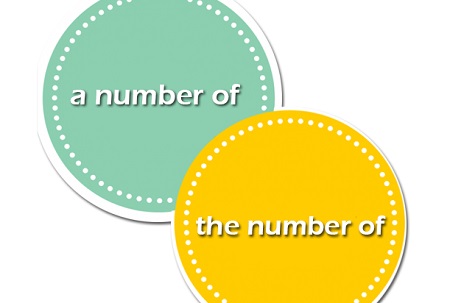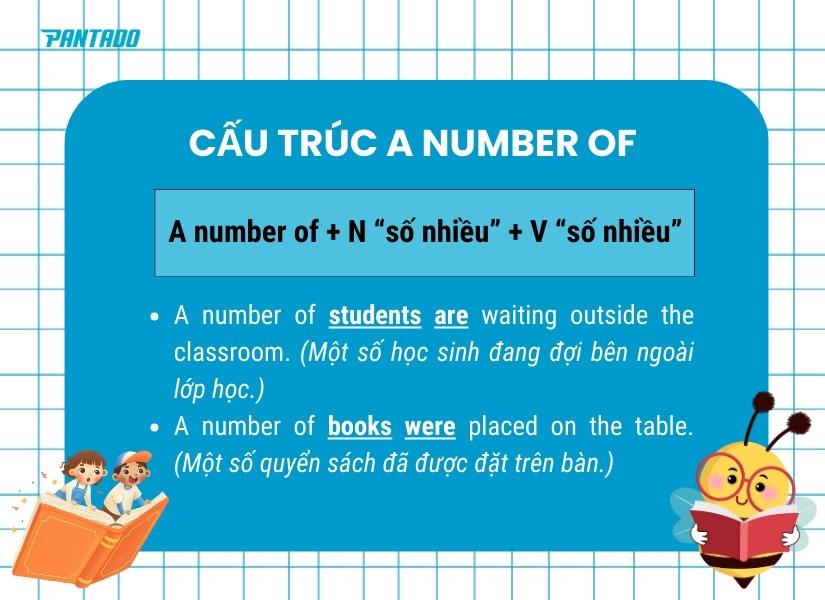Phân Biệt “A Number Of” Và “The Number Of” – Chia Số Ít Hay Số Nhiều?
07/11/2025
Tuyển sinh
Bạn có từng nhầm lẫn giữa "A Number Of" và "The Number Of" khi viết hoặc nói tiếng Anh không? Đây là hai cụm từ có vẻ giống nhau nhưng lại có cách dùng hoàn toàn khác biệt, đặc biệt là trong cách chia động từ. Nếu không hiểu rõ, bạn rất dễ mắc lỗi ngữ pháp khi sử dụng chúng. Trong bài viết này, chúng ta sẽ khám phá chi tiết sự khác biệt, cách sử dụng chính xác và những mẹo đơn giản giúp bạn tránh sai sót và cải thiện kĩ năng tiếng Anh.

1. “A number of” là gì?
"A number of" có nghĩa là "một số lượng", chỉ một nhóm đối tượng không xác định nhưng nhiều hơn một. Vì vậy, danh từ đi kèm luôn ở số nhiều và động từ theo sau cũng chia ở số nhiều.
Cấu trúc:
|
A number of + danh từ (số nhiều) + động từ (số nhiều) |

Cách sử dụng cấu trúc “A number of”
Ví dụ:
- A number of students are waiting outside the classroom.
→ (Một số học sinh đang đợi bên ngoài lớp học.) - A number of books were placed on the table.
→ (Một số quyển sách đã được đặt trên bàn.)
Lưu ý:
“A number of” nhấn mạnh vào nhóm đối tượng (danh từ số nhiều) → Động từ luôn chia số nhiều.
- A number of students is waiting outside. (Sai – động từ phải là số nhiều)
- A number of students are waiting outside. (Đúng – động từ số nhiều)
2. “The number of” là gì?
"The number of" có nghĩa là "số lượng của…", dùng để nói về một con số cụ thể liên quan đến một nhóm đối tượng. Vì tập trung vào số lượng (danh từ số ít), nên động từ theo sau luôn chia ở số ít.
Cấu trúc:
|
The number of + danh từ số nhiều + động từ số ít |

Cách sử dụng cấu trúc “The number of”
Ví dụ:
- The number of Covid-19 cases has decreased significantly.
→ (Số lượng ca nhiễm Covid-19 đã giảm đáng kể.) - The number of students in the school is increasing.
→ (Số lượng học sinh trong trường đang tăng lên.)
Lưu ý:
The number of nhấn mạnh vào con số → Động từ luôn chia số ít.
- The number of students are increasing. (Sai – động từ phải là số ít)
- The number of students is increasing. (Đúng – động từ số ít)
>> Tham khảo: Cách dùng mạo từ A – An – The dễ hiểu nhất
3. Phân biệt “A number of” và “The number of”

Phân biệt “The number of” và “A number of”
|
Đặc điểm |
A number of |
The number of |
|
Ý nghĩa |
Một số lượng không cụ thể |
Số lượng cụ thể của một nhóm |
|
Danh từ theo sau |
Số nhiều |
Số nhiều |
|
Động từ |
Số nhiều |
Số ít |
|
Ví dụ |
A number of people are attending the meeting. |
The number of attendees is increasing. |
5. Bài tập thực hành
Bài 1: Điền vào chỗ trống với động từ đúng:
1. A number of people ___ (be) interested in the new project.
2. The number of applications ___ (increase) every year.
3. A number of tourists ___ (visit) this place during summer.
4. The number of students in the school ___ (decline) recently.
Đáp án:
1. are
2. increases
3. visit
4. has declined
Bài 2: Chọn từ chính xác để hoàn thiện câu
1. A number of my friends (applies/ apply/ is applying) for university.
2. The number of foreign tourists to Vietnam (has greatly increased/ have greatly increased/ have slowly increased) over the last few years.
3. A number of experiments (was made/ was making/ were made) but they haven’t found anything.
4. The number of (people/ person/ student) attending the Philosophy course at our university is decreasing.
5. You see houses a hundred years old standing in areas where tornadoes occur (the number of/ a number of/ much) times a year.
6. (The number of people/ The number of person/ A number of person) living in the area has become too large for its infrastructure.
7. There (is/ are/ was) a number of important announcements in the bulletin.
8. The number of notebooks I had bought (were/ was/ are) twenty.
9. The number of (tomatoes is/ tomato is/ tomatoes are) fresh and juicy.
10. The number of apartments in this area (is/ was/ are) modest but elegant.
Đáp án:
1. A number of my friends apply for private universities.
2. The number of foreign tourists to Vietnam has greatly increased over the last few years.
3. A number of experiments were made but they haven’t found anything.
4. The number of people attending the Philosophy course at our university is decreasing.
5. You see houses a hundred years old standing in areas where tornadoes occur a number of times a year.
6. The number of people living in the area has become too large for its infrastructure.
7. There are a number of important announcements in the bulletin.
8. The number of notebooks I had bought was twenty.
9. The number of tomatoes she bought are fresh and juicy.
10. The number of apartments in this area are modest but elegant.
6. Kết luận
Pantado hy vọng rằng bài viết này đã giúp bạn hiểu rõ sự khác biệt giữa "A number of" và "The number of", cũng như cách sử dụng chúng một cách chính xác. Hãy theo dõi website pantado.edu.vn để cập nhật thêm nhiều kiến thức tiếng Anh thú vị nhé!
>>> Có thể bạn quan tâm: Tiếng Anh trực tuyến 1 kèm 1 cho trẻ tại nhà









